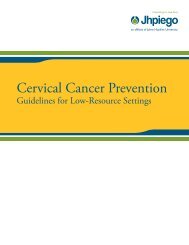Manual for Male Circumcision under Local Anaesthesia
Manual for Male Circumcision under Local Anaesthesia
Manual for Male Circumcision under Local Anaesthesia
Create successful ePaper yourself
Turn your PDF publications into a flip-book with our unique Google optimized e-Paper software.
<strong>Male</strong> circumcision <strong>under</strong> local anaesthesia<br />
Version 3.1 (Dec09)<br />
Chapter 1<br />
Benefits and risks of male circumcision<br />
Summary<br />
• <strong>Circumcision</strong> is the surgical removal of the <strong>for</strong>eskin, the fold of skin<br />
that covers the head of the penis (glans).<br />
• The benefits of male circumcision include a reduced risk of urinary<br />
tract infections in childhood, a reduced risk of ulcerative sexually<br />
transmitted diseases in adulthood, protection against penile<br />
cancer, a reduced risk of cervical cancer in female sex partners,<br />
and prevention of balanitis (inflammation of the glans), posthitis<br />
(inflammation of the <strong>for</strong>eskin), phimosis (inability to retract the<br />
<strong>for</strong>eskin) and paraphimosis (inability to return the retracted<br />
<strong>for</strong>eskin to its original location).<br />
• Complication rates following male circumcision are very low when<br />
it is per<strong>for</strong>med by well equipped and trained health care providers.<br />
• Numerous regional and global studies since the 1980s have noted<br />
a lower risk of HIV infection in circumcised men, as well as lower<br />
HIV prevalence in populations where male circumcision is<br />
common.<br />
• Randomized controlled trials in Kenya, South Africa and Uganda<br />
have demonstrated that male circumcision reduces the individual<br />
man’s risk of acquiring HIV infection by 60%.<br />
INTRODUCTION<br />
BENEFITS AND RISKS<br />
What is male circumcision<br />
<strong>Circumcision</strong> is the surgical removal of the <strong>for</strong>eskin, the fold of skin<br />
that covers the head of the penis. It is widely practised <strong>for</strong> religious<br />
and traditional reasons, often within the first two weeks after birth, or<br />
at the beginning of adolescence as a rite of passage into adulthood. It<br />
may also be per<strong>for</strong>med <strong>for</strong> medical reasons to treat problems involving<br />
the <strong>for</strong>eskin.<br />
How circumcision is per<strong>for</strong>med<br />
During a circumcision, the <strong>for</strong>eskin is freed from the head of the penis<br />
(glans) and removed. When done in a newborn baby, the procedure is<br />
simpler and quicker than in adolescents and adults. Superficial wound<br />
healing after circumcision in adults generally takes 5–7 days.<br />
However, about 4–6 weeks are needed <strong>for</strong> the wound to heal fully. In<br />
babies and young boys, the healing time is considerably shorter.<br />
Whether or not circumcision is necessary has been a subject of<br />
heated debate in many countries. In some settings, circumcision is<br />
<strong>Male</strong> circumcision and HIV infection Chapter 1-1
















